Unlocking AI's Potential: Understanding Prompt Templates
The Blueprint for Better AI Conversations.
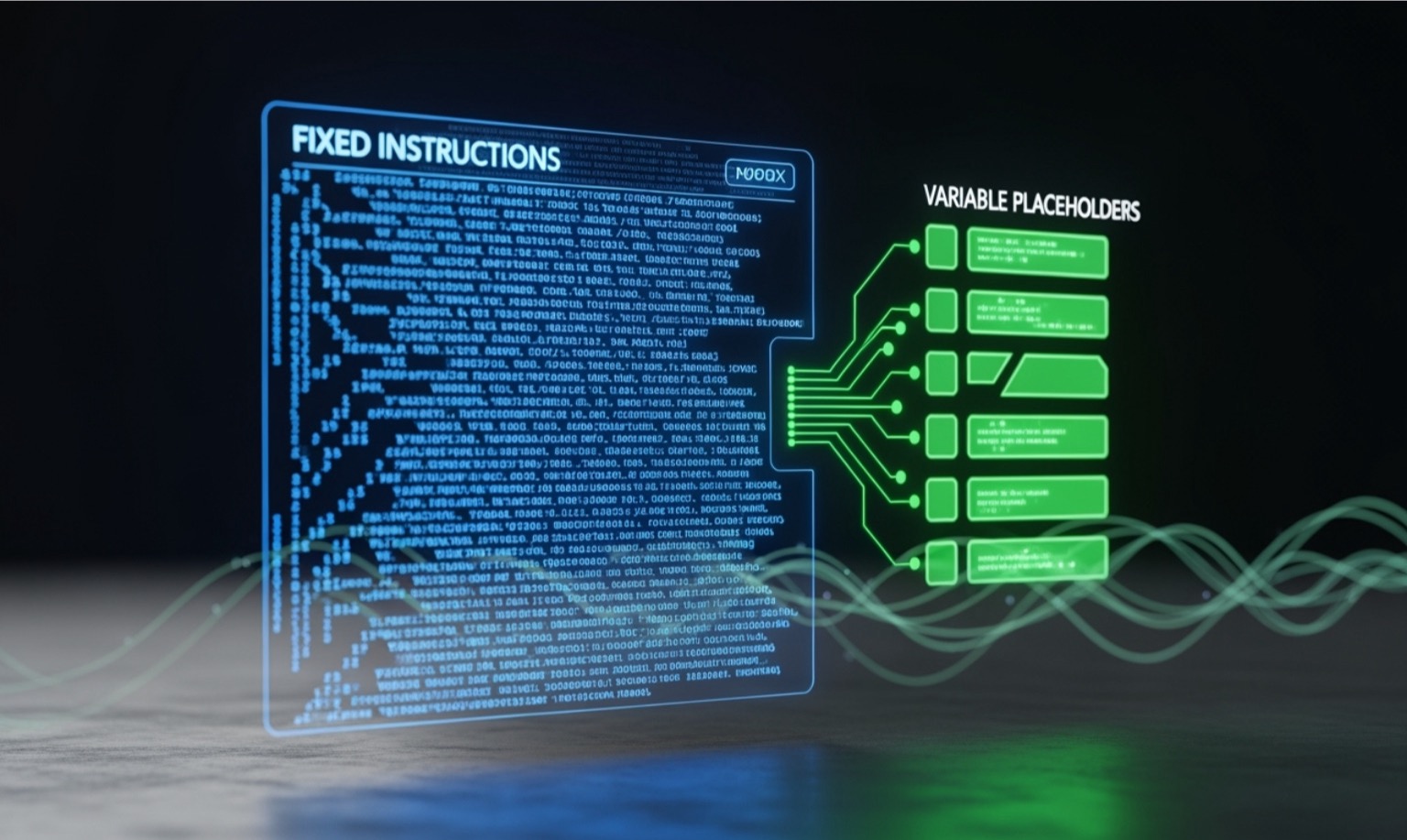
If you've ever wondered what a prompt template is here's the essential answer: A prompt template is a pre-designed structure or framework that combines fixed instructions with variable placeholders to create consistent and effective prompts for AI language models.
Key characteristics of prompt templates:
- Fixed content: Static instructions that remain the same
- Variable content: Dynamic placeholders that change based on input
- Reusable structure: Can be used repeatedly for similar tasks
- Consistent output: Ensures uniform quality across interactions
Think of prompt templates as blueprints for AI conversations. Just like architects don't redesign basic structures from scratch every time, you don't need to craft every AI prompt from zero.
The research shows that prompt templates can dramatically improve your AI interactions. They enable consistency of output, especially for code, help you avoid duplicated prompt logic, and transform prompt engineering from a solo struggle into a collaborative craft.
Whether you're generating marketing copy, extracting data, or writing code, templates provide the scaffold that guides AI models toward the exact output you need. They're particularly powerful because they separate your core prompt logic from dynamic inputs - making it easier to test, refine, and share your best-performing prompts.
Instead of wrestling with inconsistent results or losing track of what worked, templates let you build on proven patterns and focus on the creative work that matters.
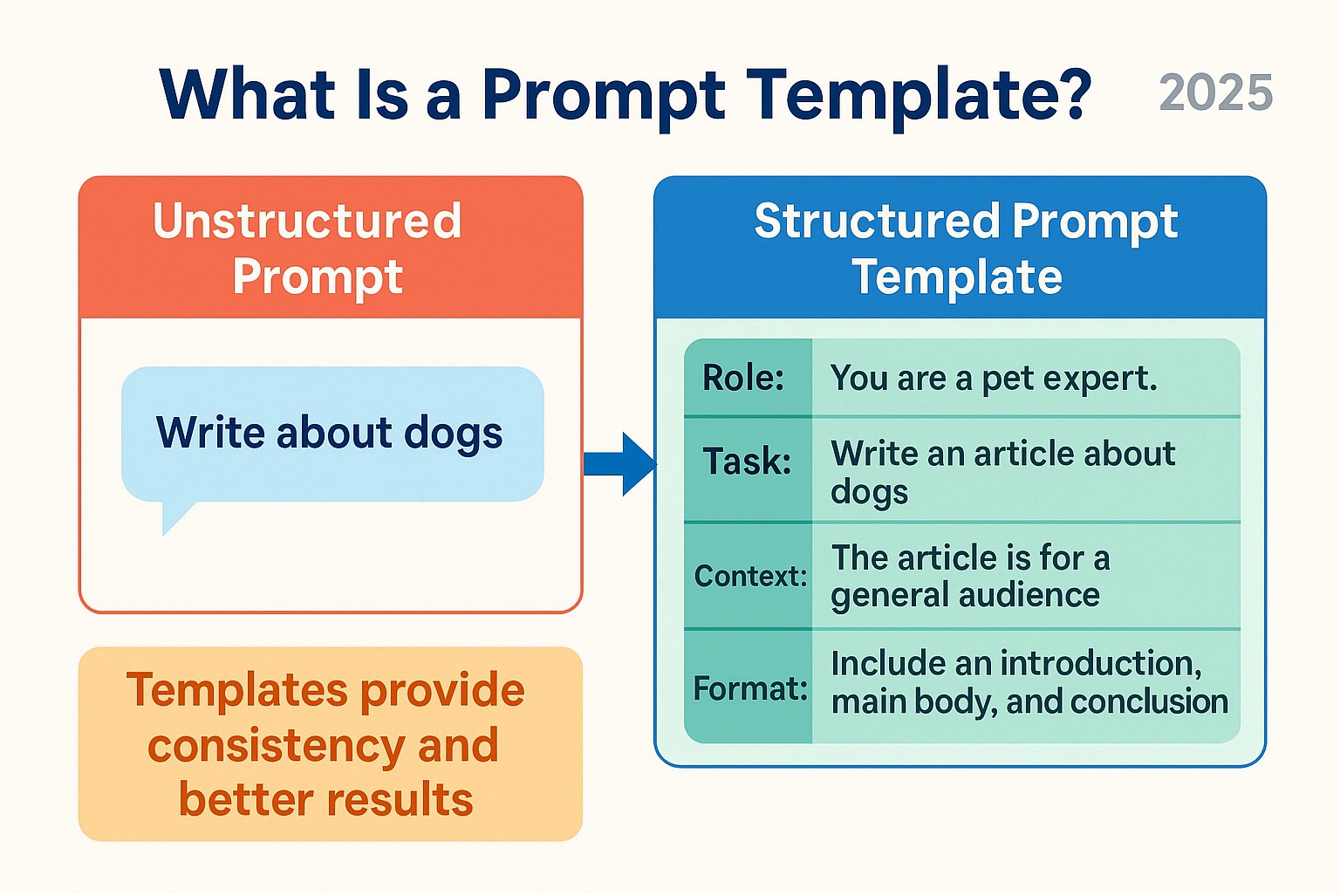
What is a Prompt Template and How Does It Work?
Think of a prompt template as a recipe for talking to AI. It provides a structured plan, ensuring every conversation follows a winning formula.
The magic happens when you combine consistency with flexibility. Your template stays the same where it matters most, but adapts perfectly to whatever specific task you're throwing at it.
Key Components and Types of Prompt Templates
Every effective prompt template is built from two essential ingredients that work together beautifully:
Fixed Content is the template's backbone, with static instructions that guide the AI's personality and approach (e.g., "Act as a helpful marketing assistant"). These rules remain constant.
Variable Content is where customization happens. These are placeholders—like {product_name}—filled with specific information for each request. Systems use markers like {curly-braces} to denote these variables.
Templates come in two main flavors, each designed for different conversation styles:
String Prompt Templates are perfect for straightforward, single-exchange interactions. They're your go-to choice when you need one clear answer to one clear question. Here's how simple they can be:
# This is a conceptual example, actual implementation may vary by library.
template = "Write a short, engaging tweet about {topic} for {audience}."
# To use: template.format(topic="AI", audience="tech enthusiasts")
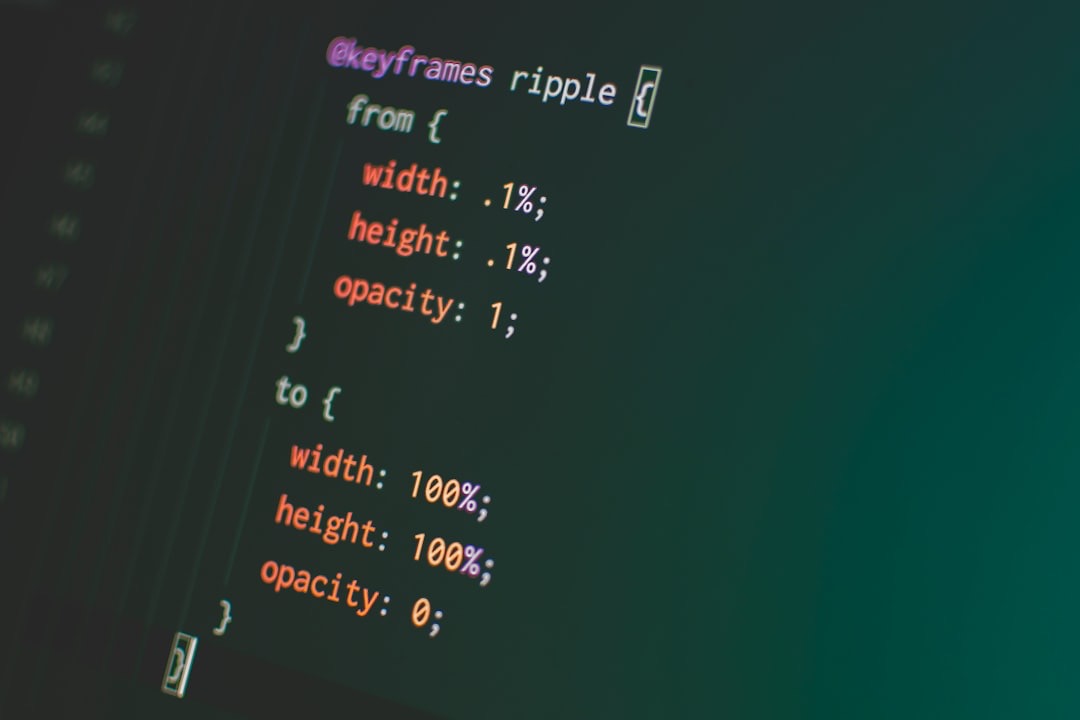
Chat Prompt Templates handle the complex stuff - full conversations with back-and-forth exchanges. These templates manage different message roles (like system instructions, user questions, and AI responses) while keeping track of conversation history. They use special placeholders to weave chat history into ongoing conversations.
This dual approach means you can handle everything from quick one-off tasks to complex, ongoing dialogues with the same structured approach.
The Advantages: Why Templates are a Game-Changer
Here's why templates will transform how you work with AI - and save your sanity in the process.
Consistency becomes your superpower. Instead of getting wildly different results every time you ask for something similar, templates ensure your AI always receives instructions in the same format. This means predictable, reliable outputs that maintain brand voice, follow technical standards, and deliver uniform quality.
Efficiency skyrockets because you're not reinventing the wheel every single time. Why write detailed instructions for every task when you can reuse proven templates? Simply plug in new information and get professional results instantly.

Scalability becomes effortless. Whether you're handling dozens of customer queries or generating thousands of unique product descriptions, templates provide the structured backbone that makes high-volume AI operations actually manageable. You're working smarter, not harder.
Quality control gets built right in. Templates capture what works, letting you build on proven patterns. You can continuously improve them with small tweaks, and the systematic approach allows for easy testing by changing only the variable parts.
Management becomes simple as your AI usage grows. Instead of juggling hundreds of prompts, you maintain a focused collection of templates that can be easily tracked, updated, and improved.
Templates don't just save time - they create a more reliable, scalable way to harness AI's power. They transform vague ideas into actionable instructions that deliver consistent results every single time.
Best Practices for Designing Effective Templates
Creating templates that actually work well takes some thoughtful planning. Here's how to build templates that will serve you well for months and years to come.
Start with crystal-clear structure. Define the AI's role, explain the task, provide context, and specify the desired output. Use line breaks to separate sections for better AI processing.
Build in flexibility from the start. Include variables where information changes, but keep the core structure stable. A good template handles various inputs gracefully while maintaining quality.
Make it task-specific by including relevant examples and guidance. For code, specify the language and style. For content, define the tone, length, and audience. The more context you provide, the better the result.
Treat templates like valuable code. Use version control, document their purpose, and add comments. This makes them easy for a team to understand, use, and share.
Test and refine regularly. AI models evolve, so your templates should too. Regularly test different approaches, measure results, and continuously improve. Test for edge cases and model limitations.
The key is finding the sweet spot between structure and creativity. The goal is to give your AI a framework for consistency without limiting innovation, helping it deliver what you want, every time.
| Feature | Prompt Templates | Ad-hoc Prompting | Few-shot Prompting |
|---|---|---|---|
| Consistency | High – Ensures uniform structure and output | Low – Varies with each manual prompt | Moderate – Consistency depends on the quality and number of examples provided |
| Reusability | High – Designed for repeated use with different inputs | Low – Each prompt is unique | High – Examples can be reused, but the overall prompt structure might change |
| Efficiency | High – Saves time by standardizing prompt creation | Low – Time-consuming to craft each prompt from scratch | Moderate – Initial setup time for examples, then efficient for variations |
| Scalability | High – Facilitates large-scale AI applications | Low – Difficult to scale due to manual effort | Moderate – Scalable for tasks within the scope of provided examples |
| Learning Curve | Moderate – Requires understanding of structure and variables | Low – Easy to start, but hard to master for consistent results | Moderate – Requires careful selection and formatting of examples |
| Use Case | Repetitive tasks with varying inputs (e.g., content generation, data extraction) | One-off, exploratory queries or highly unique tasks | Guiding models with limited data, complex tasks requiring specific output styles (often combined with templates) |
| Knowledge Sharing | High – Easily shared and standardized within teams | Low – Individual knowledge, hard to standardize | Moderate – Examples can be shared, but the context of their effectiveness might be lost |
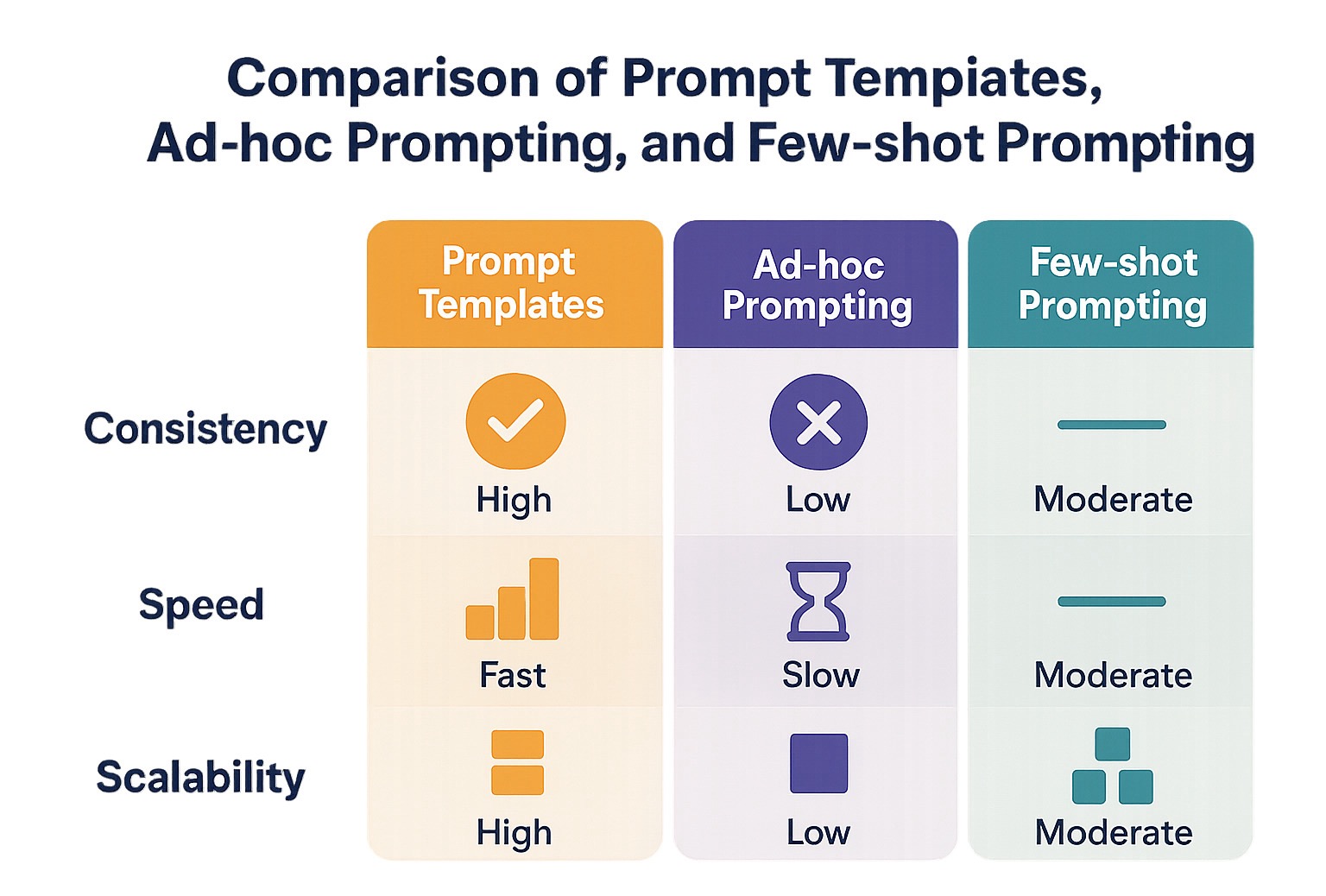
Templates work beautifully alongside other prompting techniques too. You can combine them with few-shot prompting by including examples in your template. They also pair well with Chain-of-Thought prompting by instructing the AI to 'think step by step' in the fixed content.
From Theory to Practice: Applications and Collaboration
Now that we understand what a prompt template is, let's explore where they make a real difference.
What is a prompt template used for in the real world?
Prompt templates have found their way into virtually every industry where AI plays a role. They're the secret ingredient that transforms sporadic AI experiments into reliable, scalable solutions.
Content creation is perhaps the most visible application. Marketing teams use templates to maintain consistent brand voice across blog posts, social media captions, and email campaigns. A single template can generate compelling sales copy by simply filling in variables like {product_benefits} and {call_to_action}. The result is hours saved and consistent branding.
Data extraction and analysis represents another powerful use case. Companies are using templates to guide AI models in pulling specific information from unstructured text—whether that's extracting sentiment from customer reviews, identifying key dates in legal documents, or analyzing financial reports. This turns chaotic data into actionable insights.
For developers and programmers, templates have become indispensable. They generate code snippets, functions, and entire scripts that adhere to specific coding standards. As research confirms, "Prompt templates enable consistency of output, especially for code, when adhering to the same prompt template for creating different functions." This consistency is crucial for team projects.
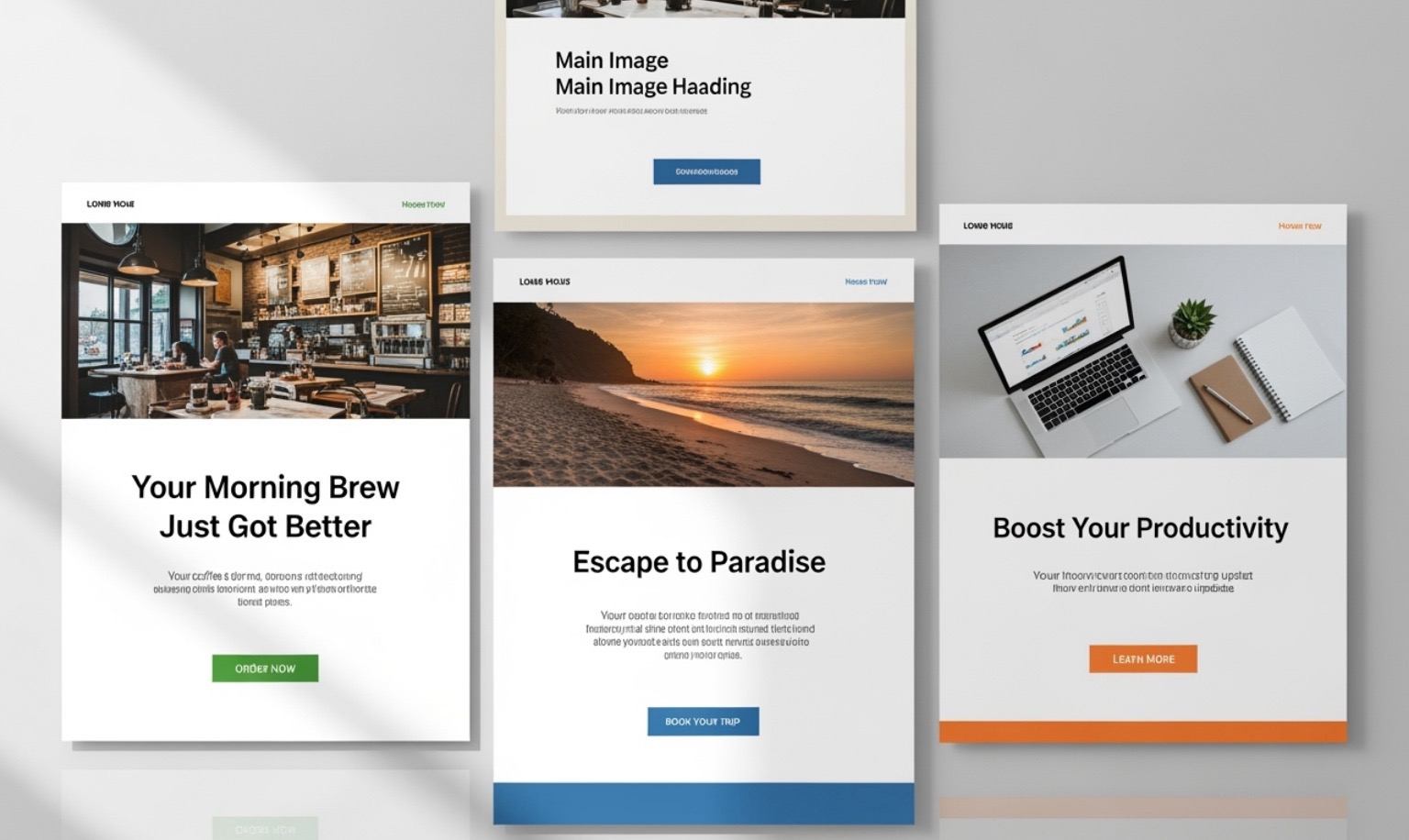
Customer service chatbots rely heavily on templates to provide consistent, helpful responses. Instead of crafting individual responses to common "How" and "What" questions, support teams create templates that ensure every customer interaction maintains the company's tone and provides accurate information.
Educational applications showcase templates' adaptability. AI tutors use them to explain complex concepts at different learning levels, breaking down difficult topics into digestible pieces custom to each student's needs.
Templates handle variation while maintaining consistency, making them perfect for testing and iterative improvement.
What is a prompt template's role in team collaboration?
Here's where prompt templates truly shine—they transform AI from a individual experiment into a team superpower.
Knowledge sharing becomes effortless with templates. When one team member finds a highly effective prompt for a specific task, they can capture that knowledge in a template and share it instantly. Templates serve as a living library of collective intelligence, preventing lost prompts and redundant work.
Standardization across teams ensures everyone speaks the same AI language. New team members can immediately leverage proven templates instead of starting from scratch. This reduces onboarding time and eliminates inconsistent results between team members.
Iterative development flourishes with templates because they provide a stable foundation for experimentation. Teams can collaboratively refine templates, track what works, and test different versions systematically. This cycle keeps everyone building on best practices together.
Centralized logic means updates happen once and benefit everyone. When core instructions need refinement or context requires updating, changes propagate across all applications using that template. This reduces maintenance and ensures consistency at scale.
Changing prompt engineering from a solo skill into a collaborative craft unlocks AI's true potential. At Potions, we're building a collaborative, community-powered AI prompt marketplace. Teams can find, remix, and evolve proven prompts together, supported by a robust version control system for easy sharing and iteration.
Explore the world's best prompts to see how collaborative prompt engineering can revolutionize your team. When everyone contributes to shared AI expertise, the whole team becomes more effective.